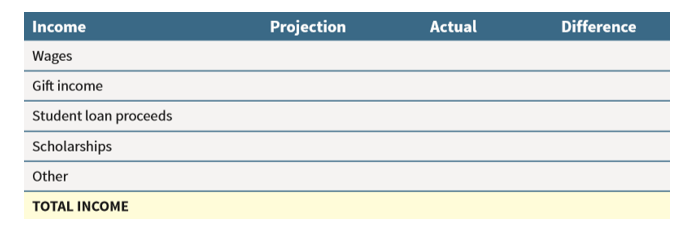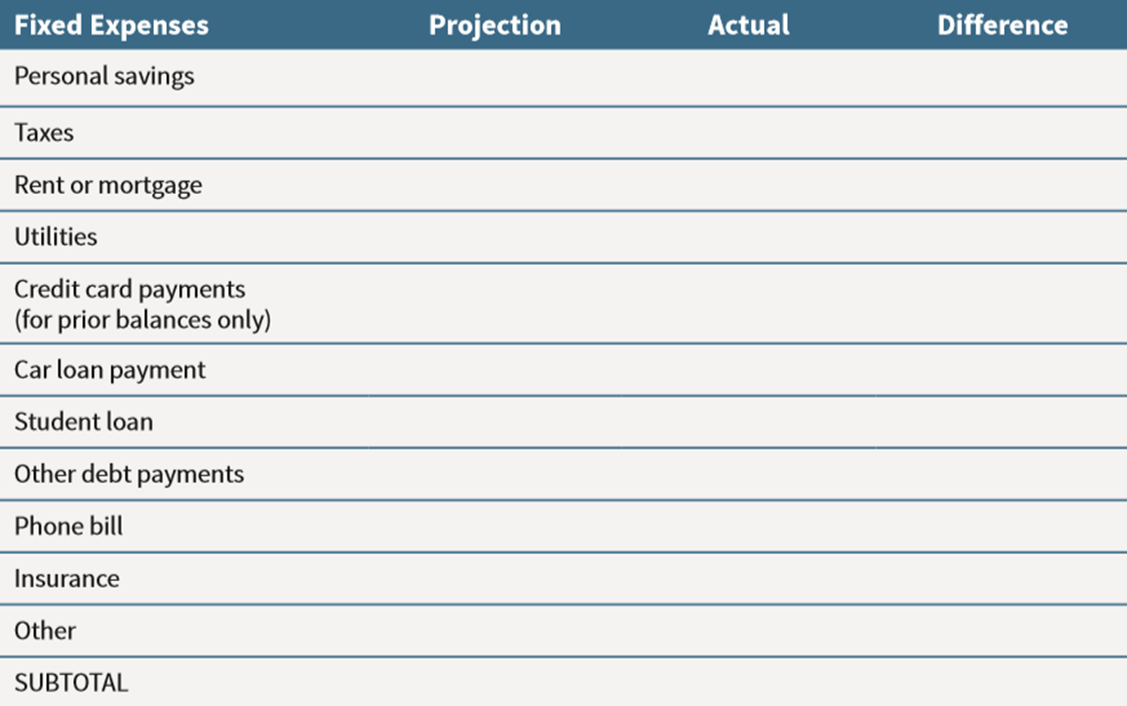Five steps to a budget
- Use the SMART approach to goal devleopment. Set and know what your goals are
- Know where your money is coming from (income)
- Know where your money is going (spending)
- A budget is a financial tool that helps regulate how quickly and in what ways your money is going to be used so that you can stay focused on accomplishing your goals
- At the end of the month, evaluate what happened Three main sections to a budget
- Income
- All resources that can be spent or saved, such as wages or salaries, interest earned, and allowances
- Expenses
- Everything, EVERYTHING, that you spend money on
- Surplus (deficit) estimate
- A surplus means that you have planned well and have your money working for you
- A deficit indicates that your expenses exceed your income
- An example budget table. You might include a projection of what each thing is, the actual value, and the difference at the end of the month

- Expenses include everything you spend money on
- Detail is important, so it may be useful to split things like utilities into more specifics like water and electricity
- Fixed expenses happen every month in fairly equal amounts such as loan payments, rent, insurance etc. Consider these your “needs”
- Saving money should also become a FIXED REGULAR EXPENSE in your budget. Just like buying food or paying utilities
- Ideally you should strive to save at least 12% of your gross income as a long term savings

- Variable Expenses are usually listed below fixed expenses because you may add or delete items over time
- For example, these are the expenses you could “do without” if the budget is a little short
- Luxuries, wants etc.
- The difference between projections and actuals can often be illimunating
- Lastly your budget should have a summary
- You should be able to anticipate whether your income will exceed or fall below your estimate of expenses
- Surplus good, deficit bad
Financial Ratios
- Just like your Balance Sheets have financial ratios, so too will the budget
- Savings Ratio
- The savings ratio indicates the percentage of money that you are setting aside on a regular basis
- (Household Savings + Employer contributions to retirement plan)/Gross income
- Strive to save at least 12% of your gross income
- Emergency Fund Ratio
- The emergency fund ratio indicates whether you have sufficient resources available in case of an emergency
- You should have resources to cover 3 to 6 months of necessary expenses
- Necessary expenses = all of your expenses minus taxes, savings, and nonessential expenses
- Consumer Debt to Income Ratio
- Indicates what percentage of your income you are using to pay debt payments (credit cards, personal loans etc.)
- Total Consumer Debt Payments/Gross Income
- Avoid spending more than 15% of your income on consumer debt payments
- Total Debt to INcome Ratio
- Indicates what percentage of your income you are using to pay ALL of your debts (consumer debt plus mortgage plus student loans)
- Total Debt Payments/Gross Income * 100
- No more than 36% of income should be used for debt payments